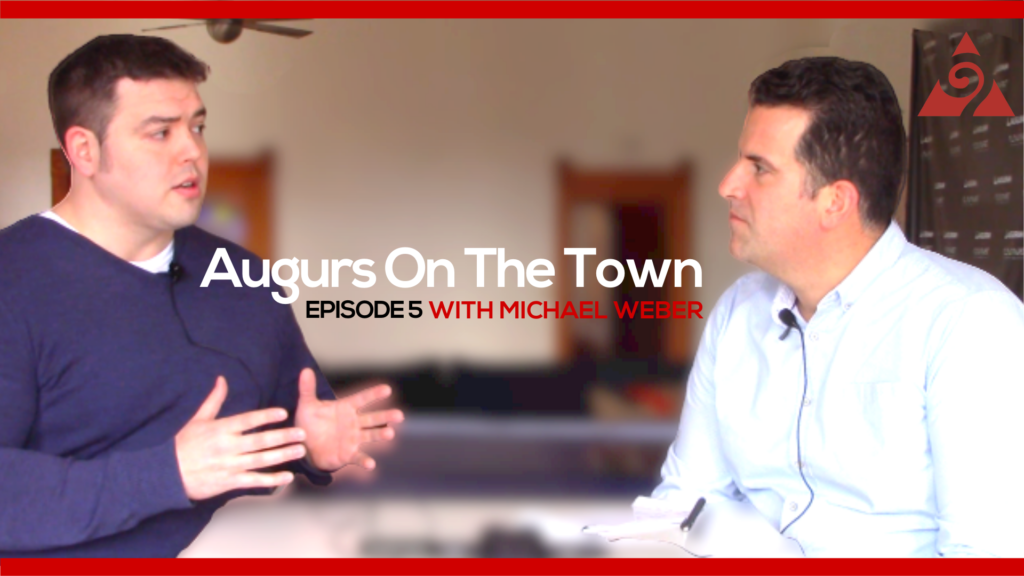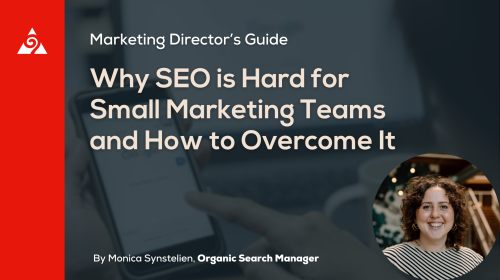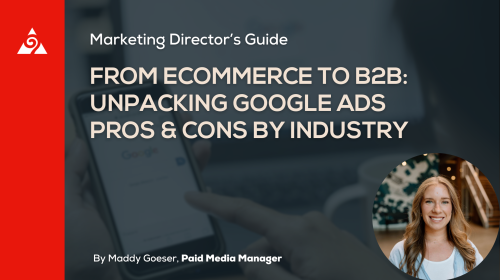How well do your sales and marketing departments align? These teams often have different mindsets and incentives, but they must still come together to generate leads and drive revenue.
In this episode of Augurs on the Town, we’re chatting with Michael Weber – CEO of Click360 – on harnessing the power of your sales and marketing teams to close deals, track progress, and measure success.
Find out more at https://augurian.com/blog/
Learn about Michael’s work at https://www.click360.io/
Transcription
Josh: Hi, everybody, this is Josh Becerra at Augurian. This is episode five of Augurs On the Town. I’m here with Michael Weber from Click 360. You and I met when you were working in house at a B2B tech client. Tell us a little bit about that experience working in house first.
Michael Weber: Sure. I took a developer role, and so we ended up doing a lot of the website stuff, but most of these things are things that you can make whatever you want out of – if they’re open to that. Then we started building out the analytics program from the marketing side, and really work with sales as well. We really wanted to get that end view and try to say, “How can we actually move the needle from marketing all the way to the revenue?”
Josh: Yes. That’s what we’re going to be talking about today. I really respect Michael and his view of the sales and marketing alignment. I think that the time at the in house client, you just gained a lot of visibility into what are the issues that happen between sales and marketing departments, and so I want to unpack that. Thanks for being here today.
Michael: Appreciate it, thank you.
Josh: What was the most common problem? What did you see what’s happening when you were in there?
Michael: I’ll generalize a little bit as well.
Josh: Okay.
Michael: Some of the most common problems are, of course, with the alignment, different mindsets, but oftentimes different incentives. Some of the things are from marketers’ point of view, you have the responsibility for your numbers, you got to prove ROI and what you’re doing is valuable, but you don’t always have the control. You need to have the salespeople or the people who are out there talking with customers in a B2B space, this is different in each organization. Talking to customers, closing the sales, and– It’s a totally different viewpoint. One of the biggest problems is just having those two different viewpoints.
The second is a lot of the other stuff like what we track, how to track it. Can we make this as painless as possible, can it be consistent? These types of things that we see a lot of?
Josh: When you say tracking, you’re talking about from the sales perspective, can we make it as painless as possible for salespeople, so that they’re actually inputting data, and we’re getting good data out of the system?
Michael: Right. Or, can we also limit the amount of data that they have to input? Because again, incentive-wise, they aren’t always incentivized to say, “Let’s work backwards and build this out”. A lot of that’s going to be how much can we automatically do and make their job really easy?
Josh: One of the things that you mentioned before that I think’s really interesting is this idea of responsibility versus control. What do you mean by that?
Michael: From marketers’ point of view, in order to be valuable to the company, you need to actually contribute to revenue, and hopefully, be able to measure that back so that we can prove it and do the things that we know are valuable.
Josh: Get the ROI.
Michael: Get that ROI.
Josh: Everybody needs ROI.
Michael: We have the responsibility for that, but we aren’t the people who are necessarily
Josh: Closing the deals.
Michael: Closing the deals. We’re not out there, we’re not talking to people. In addition to that, we have a lot of things hand-offs along the way. Some of those will be attribution that salespeople we want, hopefully, to do some attribution on there, but in addition to that, are the leads that we’re sending to sales even getting to them? Are they getting to the right person? Are they routed to the proper rules on there? We, on a lot of ways, I’ve seen where people will say, “As a marketer, I’m just going to drive leads and let them do it.” That’s really a challenging thing for most organizations to say, “Well, we really need to look end to end, but we also need to trust them.”
Sometimes it’s really hard to do. Sometimes you get the blame game, you’re giving me junk leads, and you’re not working them, and that’s a really tough thing to do, but you do need to trust them and build this over time, then also really hold them accountable and make it easy for them, hopefully, to improve revenue and trickle back and say, “Look how great we are.”
Josh: Do you have any tips that would be like when you say, “Let’s make it easy for them.”? What do you mean by that? Because I think everybody wants to make it easy for their sales team. Did you implement something at that B2B that really worked, that the sales team was able to get behind?
Michael: I think so. Part of our Click 360 platform as well is to say, “How do we track everything on this?” Then we basically will run predictive models on there for helping them prioritize on it.
Josh: Okay. Talk a little bit more about that. That was a lot, I understand it because we’ve talked about Click 360, but this idea of tracking everything so that a salesperson can see who their top priorities are. Can you like just get a little bit deeper into that?
Michael: Yes. From a slightly technical point of view?
Michael: What we basically look for is to say, “Are there ways that we can automatically group people once we track them, and we have their behavior as well as some other attributes, title and these kinds of things?” But, “Are there ways that we can automatically group people that when customer behavior changes over time, that we follow those changes?”
Then we simply say much like a Netflix or an Amazon recommendation, people like you, or people like this, are this likely to close, for example. Based on these behaviors on these learned rules. That’s some of the stuff that I’ve been working on is to say, “How can we do this without taking this rule-based approach that we see with a lot of the other marketing automation type platforms that are saying if this, this, this and this, but to actually learn from it?”
Josh: So, you can identify like, “a happy path to close a deal,” and you can start to say, “Wow, these people are on like step three of that path,” and you actually know what step four is, and you can say to the salesperson, “Send them the spec sheet or get a proposal in front of them because of these risk,” because you’ve grouped them in this way. Am I interpreting that right?
Michael: That’s a much better way to say that. Yes. That’s exactly right. Then we also see things like in the B2B sales cycle, if you’ve got a longer sales cycle than, say, right away–
Josh: Yes, not e-commerce, we’re talking the months, right?
Michael: Not e-commerce, where you do have that point where you might have talked to somebody who could be a great prospect, but when you talked to them three weeks ago, they weren’t ready. Now, we can also start to see based on that behavior. They’re a nurturer lead, and now they’re ready, and so prioritize them up.
Josh: What does that look like? Like they hit a couple of these pages or they open a couple of emails or they requested a spec sheet? What were some of the triggers that you were using to group people?
Michael: It will depend on how we do it. People can do this differently.
Josh: Well, just an example of like what you saw, and you’re like, “Yes, that’s it. That’s the trigger.”
Michael: It’s going to be learned, the way that we do it is learned from each of the companies. It will look basically at the sequence of behavior, and it will say that these are what it’s going on. Then how we do it and how we push recommendations from there is when you’re here and we see that you viewed this page, this page, watched this video, maybe downloaded this white paper, and maybe a few other people of your company did similar things, and say you’re at a 60% likelihood to convert. You should probably talk to them anyhow, but if we have one over here, this group that’s, say, 90%, then we say, “Well, what’s the difference between these two groups?” Maybe it’s watch this video, and maybe it is download this white paper, maybe it is, “Hey, this person is ready to go, send them the email with this particular thing and then trigger it.” We really just are looking at the differences between the current group and like a-
Josh: A high performing group.
Michael: -a higher performing group, and try to make you move over there.
Josh: I see. Well, we just went down a huge rabbit hole around analytics, and this is really more about the sales and marketing alignment. I think, getting the sales team behind analytics and doing their part, even if it is a small part and you’ve made it easy for them to help with the attribution and the tracking is what’s going to, in the end, benefit them and make marketing help them be smarter about prioritization. That’s basically the learning, I think, for today, right?
Michael: I think so.
Josh: Yes. Well, I want to thank you for being here, and I think we should do some follow up video more on attribution and the analytic side of things, but for today, we’re going to sign off. Again, thanks for watching Augurs On The Town with Michael Weber. See you.
Michael: Thank you.



